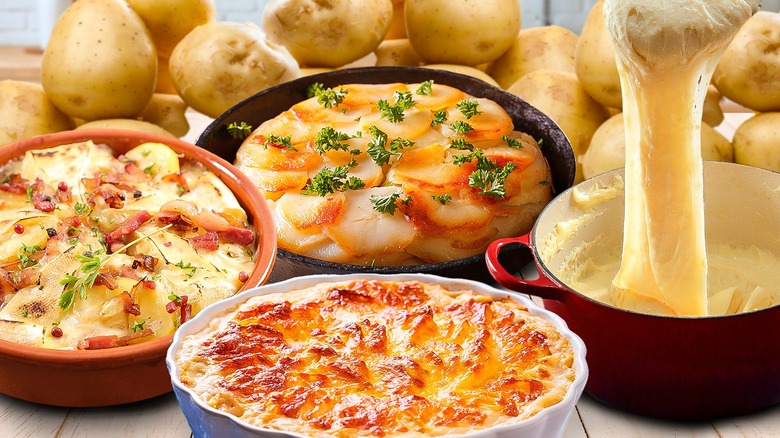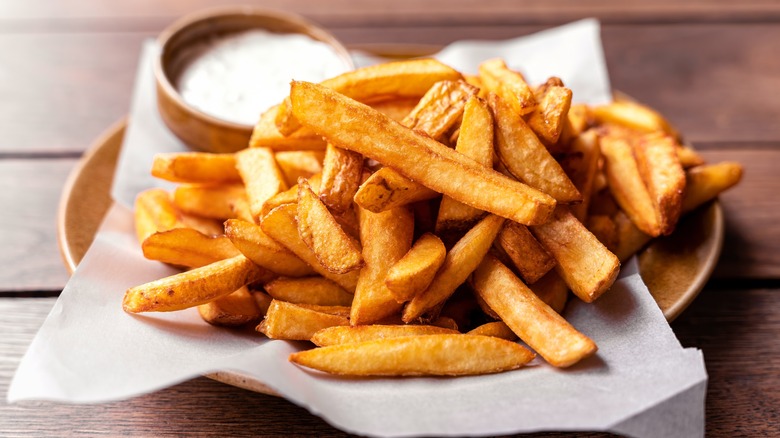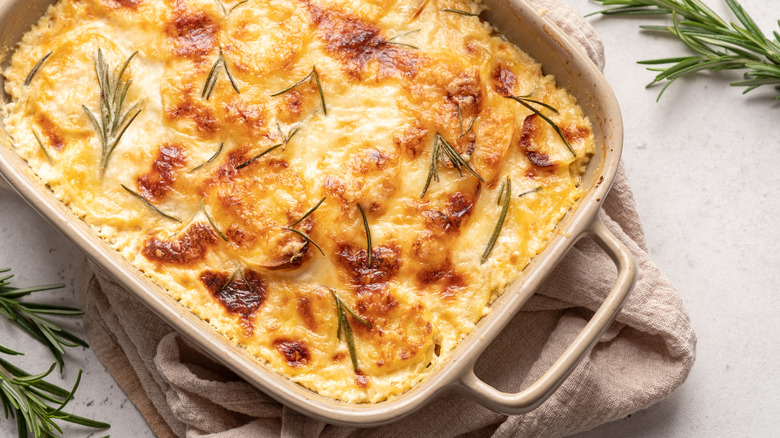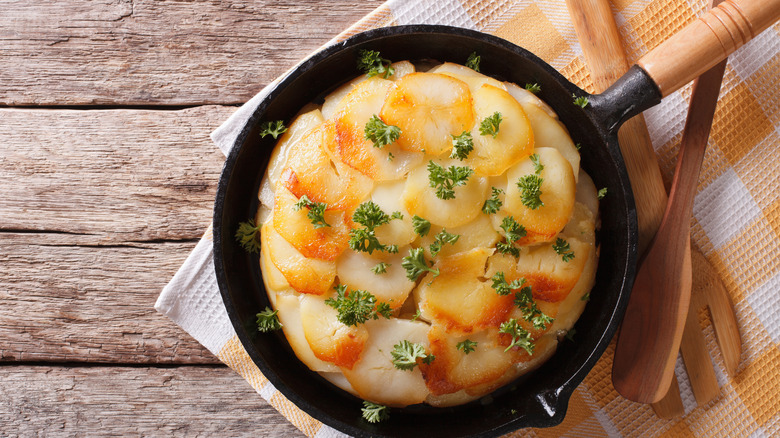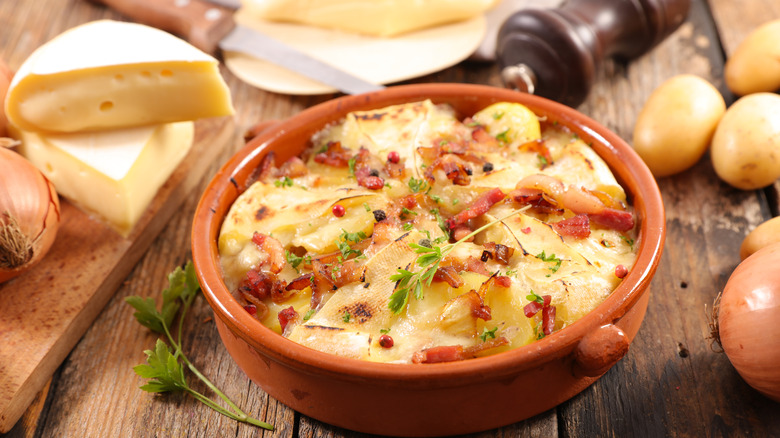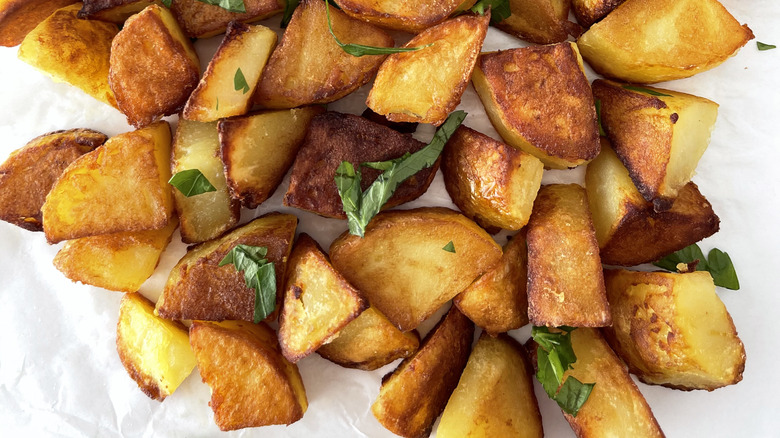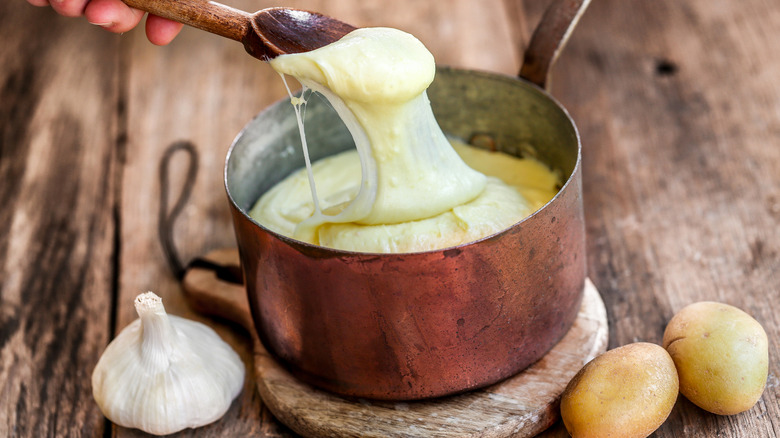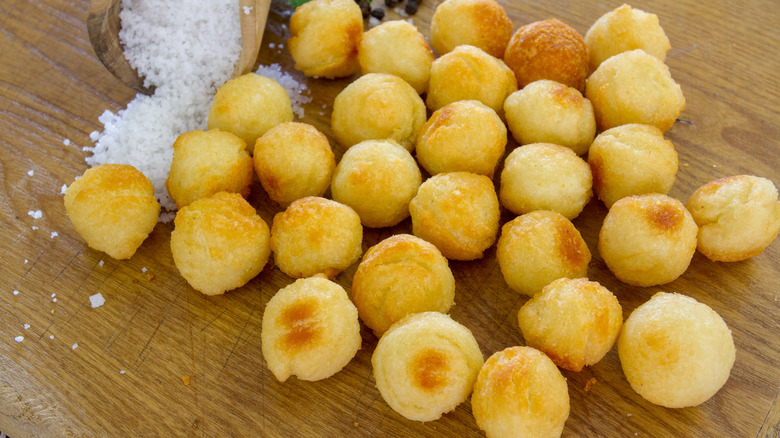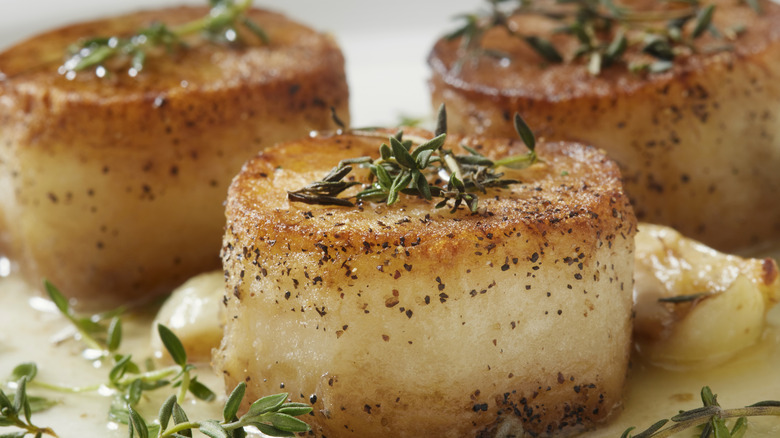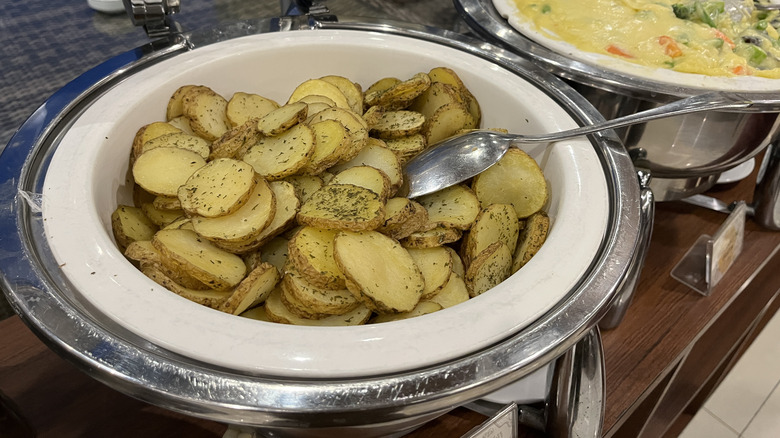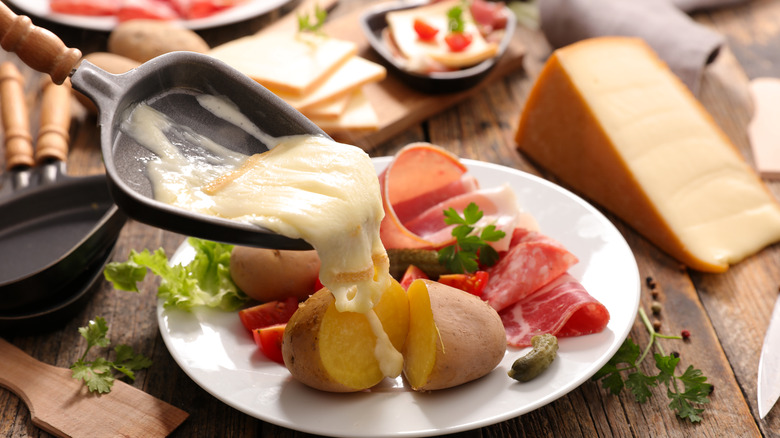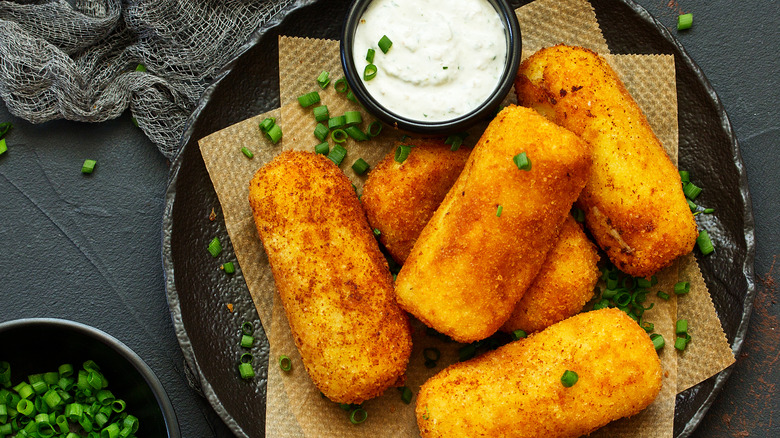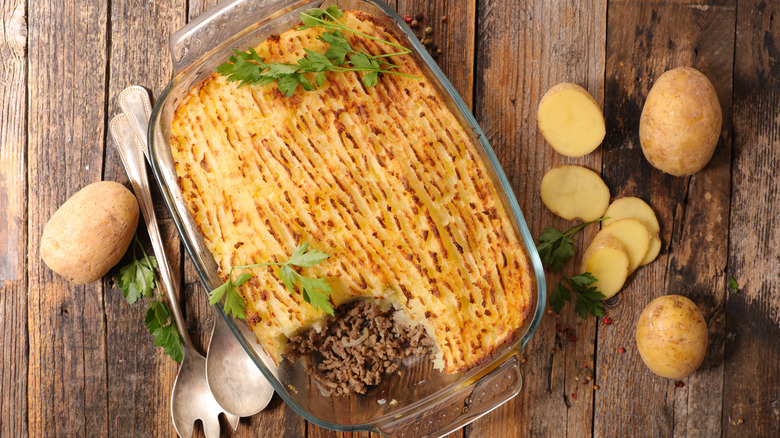12 French Potato Dishes You Should Try At Least Once
Potatoes are a central part of many European cuisines and serve as the star of tons of classic French dishes. These tubers, called "pommes de terre" (apples of the earth) in French, are one of the most commonly used vegetables in French cuisine and are served both in homey bistros and fine-dining restaurants. Potatoes are especially nourishing and comforting in colder weather, where they add extra satisfaction to many hearty and warming dishes. Their versatility is what makes them so special, and the French have invented countless delicious dishes that showcase tons of ways to serve them.
At home, you can explore a variety of French potato recipes, from creamy casseroles and rustic roasted potatoes to more refined dishes like pommes dauphine. While many of these recipes are side dishes, there are also a few French main courses that celebrate potatoes as the star of the meal. Whether they're boiled, fried, sautéed, baked, mashed, grated, sliced, or cooked whole, these recipes show how tasty and versatile the humble potato can be.
Frites (fries)
French fries, known as pommes frites or just frites in French, are as popular in American, British, and other world cuisines as they are in France. While other populations around the globe may associate fries with fast food, the French do not relegate this side dish to informal dining. Pommes frites are an integral part of a dish called steak frites, meaning "steak and fries." This dish of seared steak and crisp fries is served in most French restaurants and bistros, especially in Paris.
French fries are mostly prepared the same way around the globe. Potatoes are cut into strips of varying thickness, then deep-fried for a crispy outside and soft interior. In France, they're typically lightly salted and served with ketchup or mayonnaise. A more modern and unorthodox way to serve fries is in so-called French tacos. This fast food staple doesn't resemble Mexican tacos very closely, consisting of a wheat wrap or tortilla filled with various meats, sauces, veggies, and of course, fries. There's debate over whether the tacos originated in the cities of Lyon or Grenoble, but they're now a popular quick lunch for working people all over France.
Gratin dauphinoise (potatoes au gratin)
This dish goes by multiple names, called gratin de pommes de terre or gratin dauphinois in French, and known as au gratin potatoes or potatoes au gratin in English. Whichever name it goes by, this creamy baked casserole looks enticing but is relatively simple, making it appropriate for a dinner party or weeknight meal. It makes for an exciting and elegant side dish to roasted meats, as well as a crowd-pleasing dish for a holiday potluck.
To make gratin dauphinois, potatoes are sliced into thin discs and then layered in a casserole dish. They're then drenched in a hearty creamy sauce and often topped with grated cheese, in order to get a browned, cheesy crust on top once the dish is baked to hot and bubbly perfection. The use of cheese is what differentiates potatoes au gratin from scalloped potatoes, though it's become more common these days to add cheese to scalloped potatoes, too. The potatoes in potatoes au gratin are also often sliced much thinner than in scalloped potatoes. The gratin is usually lightly seasoned with salt and pepper but may also include nutmeg and garlic.
Pommes Anna
For a dish that truly celebrates potatoes, with few other ingredients to distract from the spuds, look to pommes Anna, which is as beautiful-looking as it is tasty. This classic and beloved French dish uses nothing but potatoes, salt and pepper, and a whole lot of butter. The potatoes are cut into thin slices and then arranged in a baking vessel in layers, overlapping each other slightly. Each layer of potatoes is drizzled with a generous amount of butter (usually clarified butter). It's then baked in the oven until the potatoes are cooked through and golden brown. This forms a potato "cake" that's served in wedges.
This impressive-looking dish does require some know-how, and many classically-trained chefs learn how to make it in Western culinary academies. Since it's meant to look perfect, home cooks may feel intimidated to make pommes Anna. Those who are confident in their skills may arrange the potatoes even more intricately, whether into a pretty flower-like pattern or in a circular pattern that makes it look like an apple tart or another elaborate dessert. Pommes Anna's elegant look makes it a true show-stopper, even though it's still considered a side dish.
Tartiflette
Created in the Alpine region of France, but wildly popular all over the country, tartiflette is a cheesy potato dish that's perfect for cold weather. While somewhat similar to potatoes au gratin, tartiflette is a more rustic dish that doesn't require any careful layering, and also includes lardons, which are small strips or cubes of fatty bacon. Authentic tartiflette also uses reblochon cheese, a cow's milk cheese with a soft-washed rind whose interior becomes incredibly gooey when melted.
This dish is a staple of ski towns in the French Alps, often during "après-ski," meaning "after ski." The fatty richness of the dish warms up skiers after hours of rigorous physical activity in freezing temperatures. Tartiflette is best served with a green salad in vinaigrette to cut through the heaviness.
While most French cooks might insist that you have to use reblochon cheese in this dish, some say that this notion is all part of a marketing campaign for reblochon. This cheese can also be hard to find outside of France. In fact, reblochon is among a list of French cheeses that are banned from being imported to the U.S., since it doesn't meet the minimum period of aging (50 days) required by the FDA. This makes reblochon a "raw milk" cheese by U.S. standards. However, American cooks can still use any gooey washed-rind cow's milk cheese, such as Camembert or Taleggio, to make a delicious (if modified) tartiflette.
Pommes persillade
If you're looking for a more accessible French potato recipe for a weekend morning, pommes persillade can class up a simple brunch. This jazzed-up version of home fries is quite easy to make, with a high reward: crispy fried potato cubes topped with a mix of fresh herbs. In French cuisine, persillade is a green herb mixture that's similar to salsa verde or a kind of chimichurri, centering around parsley ("persil" means parsley in French) and sometimes other herbs, as well as garlic, oil, and vinegar. Many home cooks in France make big batches of persillade and freeze it in ice cube trays, so they're ready to be added to potatoes and other dishes in an instant.
To make pommes persillade, potatoes are parboiled, cut into cubes, and fried in hot oil. The persillade is added to the pan right at the end, and the fragrant aroma of garlic and herbs will wow any guests you have over. It's as much of a delicious addition to eggs and bacon as it is to a steak dinner or roasted fish dish.
Pommes aligot
If you've never heard of pommes aligot, or aligot potatoes, imagine a love child of mashed potatoes and cheese fondue. This dish originated in Aubrac in the southern region of France, where locals added stretchy cheese to plain mashed potatoes to create a silky-smooth pot of comfort food. With all the best qualities of a bowl of buttery mashed potatoes and a pond of viscous melted cheese, aligot stretches into a satisfying "cheese pull" when you spoon it out of the pot. The dish takes advantage of not only the ooziness of cheese, but also the rather stretchy and gummy qualities of potatoes that have been mashed for an extended period of time.
While it's quite a rich dish that's suitable for winter, pommes aligot is enjoyed all year round in France. It's also surprisingly easy to make at home, especially if you're prone to over-mashing your potatoes and need a way to save them. For the right consistency, the spuds actually need to be overworked to the point of glueyness before they're combined with the cheese. The dish is also commonly docked up with garlic and cream.
Pommes dauphine
A dish that's a bit more obscure outside of France, pommes dauphine are potato puffs that should be more popular worldwide. These bite-size treats are like a cross between an éclair and a tater tot, as they make use of choux dough, the same puff pastry used in profiteroles (cream puffs) and more. They're made by rolling a mix of mashed potato and choux dough into little balls, or by wrapping small mashed potato balls in choux pastry dough. They're then deep-fried into crispy little puffs.
The choux forms a delicate crust on the outside of good pommes dauphine, and the inside is like a feathery cloud. While the small dumplings themselves are not hard to shape and fry, making the choux pastry is quite labor-intensive. For dedicated home cooks, the effort can be worth it. These moreish morsels are the perfect appetizer for a dinner party or brunch, and can also be served as individual hors d'oeuvres with toppings. Just be careful not to devour them all before your guests arrive.
Pommes de terre fondantes (fondant potatoes)
On the opposite end of rustic dishes like pommes aligot are fancy, restaurant-worthy preparations like fondant potatoes. Much like the name might suggest, these potatoes melt in your mouth the way a chocolate fondant (chocolate lava cake) would, and each morsel of potato even looks a bit like an oval-shaped, miniature cake.
Fondant potatoes, or pommes de terre fondantes, are made with small potatoes with either end sliced off to create perfect rounds. The potatoes are seared in a hot pan while being basted with butter, then they're braised in a flavorful stock until the interiors are cooked through. The top and bottom of each round becomes browned and crisp, while the rest of the potato is soft, yet holds its shape for an elegant presentation. As long as you manage to get each fondant potato cooked through, this spectacular side dish is not too challenging to make at home.
Lyonnaise potatoes
Pommes lyonnaise, or Lyonnaise potatoes, come from the titular city of Lyon. This city is known for its "bouchons," small bistros that were created around the 17th century to feed the city's silk workers. Pommes lyonnaise are just one dish that laborers looked forward to eating after a hard day's work. Today, the bouchons of Lyon continue the tradition of serving rustic, hearty meals from the city's culinary heritage.
Pommes lyonnaise are potatoes that are boiled, sliced, then pan-fried in butter until slightly crisp and sprinkled with fresh parsley. At a classic bouchon, they may be served alongside sausage, roast beef, veal liver, pork chops, and more. They can also be found in more hip eateries around their native city, which serve them as a side to burgers, steak, and even with eggs Benedict at brunch. Some recipes also fry onions or lardons with the potatoes. They make a perfect substitute for hash browns or basic roast potatoes if you want to change up your side dishes without too much effort.
Raclette
Though raclette originated in Switzerland, it's become beloved in the Alps region of France. Similar to tartiflette, this rich and cheesy dish is associated with after-skiing meals. Raclette is actually centered around cheese more so than potatoes, but you can't have an authentic version without boiled spuds.
Raclette is a type of cheese that is typically placed on a table griddle until it starts to melt. Usually, all the diners at the table have their own raclette paddle that they use to melt and serve the cheese. The gooey raclette is scraped on top of plates of steamed, roasted, or boiled potatoes and eaten with an assortment of toppings like pickles (usually pickled cucumbers and onions) and various hams.
The potatoes are important to get right, since they have to be on the firmer side in order to hold their shape and support the cheese and other toppings. This means they're usually boiled until just cooked through. The best potatoes to use are new potatoes, as their small size makes for the perfect cheese-to-potato ratio. Many claim that for an authentic raclette experience, the potatoes have to be served with their skins, but some cooks peel them according to their preference.
Potato croquettes (croquettes de pommes de terre)
While they are believed to have originated in France, potato croquettes are a popular finger food around the world. The Italians, Dutch, and Spanish enjoy croquettes very similar to those found in France, while Cuba, Brazil, Japan, and many other nations are home to more localized versions.
Classic croquettes consist of smooth mashed potatoes mixed with egg yolks, flavorings like chives or powdered seasonings, and butter, then formed or piped into bite-sized shapes, rolled in breading, and deep-fried to finish. They can easily be picked up with your hands, and should hold their shape, despite being so soft and creamy on the inside (and possibly dunked into dipping sauce). Croquettes can come in many shapes, but the easiest to make are simple rolled balls or flattened patties. They're perfect as a vegetarian snack, but are also sometimes made with ham, fish, shrimp, and other meaty fillings mixed into the mash.
Hachis Parmentier
Hachis Parmentier is similar to a French version of shepherd's pie or cottage pie. It's a common belief that it came to be as a way to use up leftover meat and vegetables. This pie has become a popular weeknight meal in France, with countless different recipes for making it from scratch and many frozen versions available in French supermarkets. With a blanket of fluffy mashed potatoes covering a tasty later of minced meat filling, this is a casserole that is a hit with both kids and adults, making it a firm favorite for family meals. It's also an easy make-and-go dish to take to a potluck dinner, especially in the wintertime.
Hachis Parmentier takes its name from a historical figure central to the modern French affection for potatoes: 18th-century pharmacist Antoine-Augustin Parmentier, who spent his life teaching the French people how to grow and prepare potatoes, after learning about them in Germany where he was imprisoned during the war. At the time, the French viewed potatoes as a lowly food only fit for feeding animals. Parmentier promoted the humble veggie as nutritious and resilient in times of famine and invented many potato dishes of his own to show Parisians how to appreciate the crop. Most of the dishes on this list are likely owed to his influence in changing the French people's opinion on potatoes.
